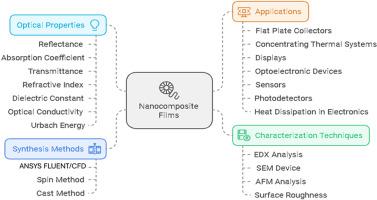Experimentally and numerically investigation of the effect of CuO:Cr2O3 nanoparticles in a carbon ash coating on flat plate collectors, enhancing the absorption of solar energy collection
IF 5
2区 工程技术
Q1 ENGINEERING, MECHANICAL
International Journal of Thermal Sciences
Pub Date : 2025-10-06
DOI:10.1016/j.ijthermalsci.2025.110347
引用次数: 0
Abstract
The present work, a new nanocomposite film of carbon ash (C) doped nanoparticles (CuO and Cr2O3) at various concentrations was synthesized by a spin coating method. Tested across 238–900 nm wavelengths. These films aim to make a nanocomposite film as a coating over the flat plate collector to absorb the solar energy. The optical properties and Urbach energy were computed, and the analysis of scanning electron microscope/energy dispersive spectroscopy of carbon ash was used to illustrate the elemental compositions. The energy gap decreased from 3.95/1.4 eV, while Urbach energy increased from 12.35/34.48 eV as the disorder increased in the band gap. The atomic force microscope illustrated that the roughness increased from 2.73/9.33 nm, while the root mean square increased from 3.48/11.4 nm. The high dielectric constant increased from 1.893/3.330, the carrier concentration per effective mass values decreased from 8.193 × 1061/0.0511 × 1061 (kg. m3)−1. The effective single oscillator energy values increased from 5.22/11.89 eV, the dispersion energy increased from 8.63/18.97 eV, the oscillator strength increased from 3.473 × 1013/14.68 × 1013, and the oscillator wavelength, decreased from 237.61/104.23 nm. The static refractive index decreased from 1.712/1.511, and the frequency dielectric constant decreased from 2.961/2.280. Linear susceptibility decreased from 0.156/0.127 esu, and non-linear susceptibility increased from 0.1012 × 10−14 to 4.421 × 10−14 esu. The computational fluid dynamics tools in ANSYS FLUENT were used to design a flat plate collector with a thin film nanocoating to predict heat loss efficiency and fluid temperature, and to increase the absorption efficiency of solar radiation to 67 %. These films coat flat plate collectors, concentrating thermal systems, optoelectronic devices, and dissipating heat from electronic systems.

碳灰涂层中CuO:Cr2O3纳米颗粒对平板集热器增强太阳能集热器吸收的实验和数值研究
本文采用自旋包覆的方法合成了不同浓度的碳灰(C)掺杂纳米粒子(CuO和Cr2O3)的纳米复合膜。测试范围为238-900 nm波长。这些薄膜的目的是制造一种纳米复合薄膜,作为平板集热器上的涂层来吸收太阳能。计算了碳灰的光学性质和乌尔巴赫能,并利用扫描电镜和能谱分析分析了碳灰的元素组成。随着带隙中无序度的增加,能隙从3.95/1.4 eV减小,而Urbach能从12.35/34.48 eV增大。原子力显微镜下粗糙度从2.73/9.33 nm增大,均方根从3.48/11.4 nm增大。高介电常数由1.893/3.330增加,载流子浓度由8.193 × 1061/0.0511 × 1061 (kg)降低。m3)−1。有效单振能值从5.22/11.89 eV增加,色散能从8.63/18.97 eV增加,振子强度从3.473 × 1013/14.68 × 1013增加,振子波长从237.61/104.23 nm减少。静态折射率从1.712/1.511降低,频率介电常数从2.961/2.280降低。线性敏感性从0.156/0.127 esu下降,非线性敏感性从0.1012 × 10−14增加到4.421 × 10−14 esu。利用ANSYS FLUENT中的计算流体动力学工具设计了一种带有纳米薄膜涂层的平板集热器,预测了集热器的热损失效率和流体温度,并将太阳辐射的吸收效率提高到67%。这些薄膜覆盖平板集热器,集中热系统,光电设备,并从电子系统散热。
本文章由计算机程序翻译,如有差异,请以英文原文为准。
求助全文
约1分钟内获得全文
求助全文
来源期刊

International Journal of Thermal Sciences
工程技术-工程:机械
CiteScore
8.10
自引率
11.10%
发文量
531
审稿时长
55 days
期刊介绍:
The International Journal of Thermal Sciences is a journal devoted to the publication of fundamental studies on the physics of transfer processes in general, with an emphasis on thermal aspects and also applied research on various processes, energy systems and the environment. Articles are published in English and French, and are subject to peer review.
The fundamental subjects considered within the scope of the journal are:
* Heat and relevant mass transfer at all scales (nano, micro and macro) and in all types of material (heterogeneous, composites, biological,...) and fluid flow
* Forced, natural or mixed convection in reactive or non-reactive media
* Single or multi–phase fluid flow with or without phase change
* Near–and far–field radiative heat transfer
* Combined modes of heat transfer in complex systems (for example, plasmas, biological, geological,...)
* Multiscale modelling
The applied research topics include:
* Heat exchangers, heat pipes, cooling processes
* Transport phenomena taking place in industrial processes (chemical, food and agricultural, metallurgical, space and aeronautical, automobile industries)
* Nano–and micro–technology for energy, space, biosystems and devices
* Heat transport analysis in advanced systems
* Impact of energy–related processes on environment, and emerging energy systems
The study of thermophysical properties of materials and fluids, thermal measurement techniques, inverse methods, and the developments of experimental methods are within the scope of the International Journal of Thermal Sciences which also covers the modelling, and numerical methods applied to thermal transfer.
 求助内容:
求助内容: 应助结果提醒方式:
应助结果提醒方式:


